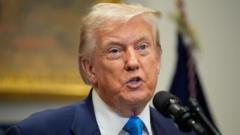Will Trump's New 15% Tariff on South Korea Reshape Trade Relations?

Understanding the Impact of Trump's Trade Deal with South Korea
The recent announcement by President Donald Trump regarding a 15% tariff on imports from South Korea has sent ripples through the global economy. This deal, touted as a step toward a "Full and Complete Trade Deal," aims to foster better trade relations between the United States and South Korea while avoiding even higher tariffs that were looming on the horizon. In this article, we will delve into the specifics of this agreement, its implications for both countries, and the broader consequences for international trade.
The Details of the Trade Agreement
On the Truth Social platform, President Trump outlined the key elements of the trade agreement with South Korea. The 15% tariff is significantly lower than the potential 25% levy that South Korea would have faced had negotiations failed. This substantial reduction is a crucial feature of the deal, allowing South Korea to maintain a competitive edge in the American market.
South Korean President Lee Jae Myung expressed satisfaction with the agreement, stating it places his country on equal or better footing compared to other nations. This sentiment indicates a strategic maneuver by South Korea to enhance its economic position in the face of fluctuating international trade policies.
Investment and Energy Commitments
As part of the deal, South Korea has pledged to invest a staggering $350 billion in the United States. This investment is set to fund projects handpicked by Trump, signaling a strong partnership between the two nations. Additionally, South Korea will purchase $100 billion worth of liquefied natural gas and other energy products from the U.S., further solidifying energy ties.
Market Access and Product Acceptance
Another critical aspect of the agreement is South Korea's commitment to accept American goods such as cars, trucks, and agricultural products without imposing import duties. This aspect aims to enhance American exports and create a more balanced trading environment. The promise of open markets could lead to increased sales for American manufacturers and farmers in South Korea.
The Timing of the Announcement
The timing of this announcement is significant, as it comes just a day before the August 1 deadline for trade agreements with the U.S. Countries that fail to negotiate could face heightened tariffs, further complicating their trade relations. This urgency has likely played a role in South Korea's willingness to strike a deal, as avoiding a 25% tariff could save Korean businesses billions of dollars.
Potential Economic Implications
The trade deal between the U.S. and South Korea has far-reaching implications for both economies. For the United States, the agreement is expected to boost manufacturing and create jobs. Trump has consistently argued that tariffs will protect American jobs and strengthen the domestic economy.
However, the volatility of Trump's trade policies has raised concerns among economists. Critics argue that such tariffs often lead to increased prices for consumers, as businesses may pass on the costs of tariffs to customers. This could offset any potential benefits gained from increased domestic production.
Consumer Impact and Market Reactions
The imposition of tariffs often leads to complex reactions in the marketplace. While some American industries may benefit from reduced foreign competition, others could suffer from increased import prices. The automotive sector, in particular, is one to watch, as American consumers may face higher prices for imported vehicles.
Moreover, international relations could be strained as other trading partners react to the new tariffs. Countries may retaliate by imposing their own tariffs on American goods, which could lead to a tit-for-tat trade war. This has been a hallmark of Trump's trade approach, leading to uncertainty in the global marketplace.
The Road Ahead for U.S.-South Korea Relations
As President Lee Jae Myung prepares to visit the White House in the coming weeks, the focus will be on how both nations can capitalize on this agreement. The meeting could pave the way for further collaboration and may serve as a model for future trade negotiations with other countries.
The South Korean economy has shown resilience in the face of global challenges, and this deal could enhance its position in the Asia-Pacific region. The potential for increased investment from South Korea into the U.S. could create jobs and stimulate growth in various sectors.
Conclusion: What Lies Ahead
In conclusion, the trade agreement between the United States and South Korea represents a strategic move to strengthen economic ties while avoiding the pitfalls of higher tariffs. As this partnership unfolds, it will be crucial to monitor the impacts on both economies and the global trading landscape. The complexities of international trade require ongoing attention and adaptability, as the stakes are high for all involved.
FAQs about the U.S.-South Korea Trade Deal
What is the main feature of the U.S.-South Korea trade deal?
The main feature is a 15% tariff on imports from South Korea, significantly lower than the potential 25% tariff that would have been imposed without the agreement.
How much will South Korea invest in the U.S.?
South Korea has committed to investing $350 billion in the United States for various projects selected by President Trump.
What products will South Korea import from the U.S. under this deal?
South Korea will import American goods, including cars, trucks, and agricultural products, without imposing import duties.
How might this agreement affect American consumers?
While it may lead to job growth in certain sectors, the imposition of tariffs could increase prices for imported goods, potentially affecting American consumers negatively.
As we look to the future, how do you think this trade deal will shape economic relations globally? Will it lead to greater cooperation or more trade tensions? #TradeDeal #Economy #SouthKorea
```Published: 2025-07-30 23:56:07 | Category: wales



